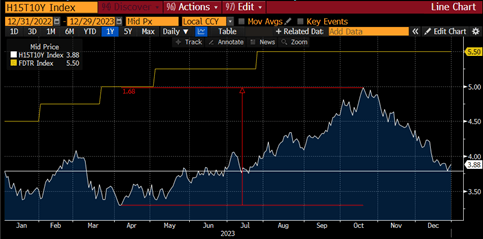Attractive income levels to start the year
Doug Drabik discusses fixed income market conditions and offers insight for bond investors.
A lot was going on with rates in 2023, yet, at the end of the year how different were things? The 10-year Treasury yield's lowest closing was 3.30%, while its highest close was 4.98%. This 168 basis point swing represents a 13.7-point price swing under today’s 10-year Treasury bond ($110.02 versus $96.29). That’s a lot of volatility. Yet, we started the year at a 3.79% yield and ended the year 9 basis points higher at 3.88%, or only a 0.76 point price swing. The year’s interim volatility is attributed to market’s uncertainty towards economic data releases, geopolitical events, upcoming domestic elections, inflation, a potential recession and the perception of the Federal Reserve’s action or inaction.
The gold line on the graph represents the upper bound Fed Funds rate. The four stair steps show the four Fed hikes throughout the year. In March, the market took a big pause, fearful that the collapse of Silicon Valley Bank might be the start of a more expansive banking crisis. The Fed continued its focus and perseverance to combat inflation with continued hikes. The market relaxed its fears and the trend of rising rates resumed and continued through October. Since October, the market has not only signaled its confidence that the Fed is done but is likely pricing in a consensus total of 75 basis points in Fed rate cuts (3 x 25bp) in 2024. There are a couple of important takeaways to observe from 2023. It would be easy to cultivate a rate bias or anchor bias to the peak rates experienced in October. Don’t – the current rate levels can’t be matched without going back in time over 15 years! In other words, our current rate environment provides fixed income buyers with historically strong levels of income. This Monday morning the 10-year Treasury is once again above 4.0%.
Should the economy avoid a deep or meaningful recession and remain strong through full employment and continued consumer participation, a slowdown will likely be met with a shift in monetary policy with a consensus 2-4 small cuts in the Fed Funds rate. However, changes in employment, earnings and/or consumer behavior could impact policy change pushing the Fed to move more decisively. History shows that the Fed will not hesitate to cut rates quickly in hopes of accelerating positive influence on a faltering economy.
Don’t try to outguess and time the market when what we know right now is that income levels are relatively attractive. Start the year focused on the income in hand.
The author of this material is a Trader in the Fixed Income Department of Raymond James & Associates (RJA), and is not an Analyst. Any opinions expressed may differ from opinions expressed by other departments of RJA, including our Equity Research Department, and are subject to change without notice. The data and information contained herein was obtained from sources considered to be reliable, but RJA does not guarantee its accuracy and/or completeness. Neither the information nor any opinions expressed constitute a solicitation for the purchase or sale of any security referred to herein. This material may include analysis of sectors, securities and/or derivatives that RJA may have positions, long or short, held proprietarily. RJA or its affiliates may execute transactions which may not be consistent with the report’s conclusions. RJA may also have performed investment banking services for the issuers of such securities. Investors should discuss the risks inherent in bonds with their Raymond James Financial Advisor. Risks include, but are not limited to, changes in interest rates, liquidity, credit quality, volatility, and duration. Past performance is no assurance of future results.
Investment products are: not deposits, not FDIC/NCUA insured, not insured by any government agency, not bank guaranteed, subject to risk and may lose value.
To learn more about the risks and rewards of investing in fixed income, access the Financial Industry Regulatory Authority’s website at finra.org/investors/learn-to-invest/types-investments/bonds and the Municipal Securities Rulemaking Board’s (MSRB) Electronic Municipal Market Access System (EMMA) at emma.msrb.org.




